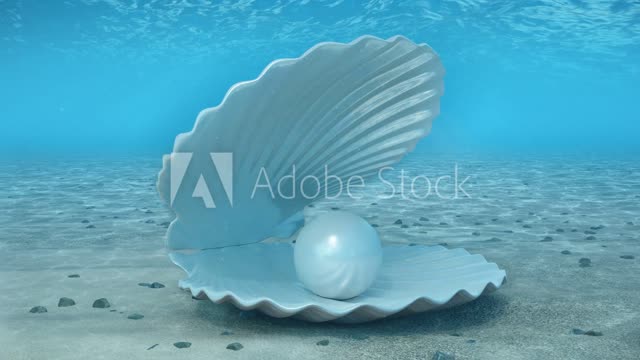Premium Only Content

How India is building a pearl farming industry
http://destyy.com/edHbkM
By Priti Gupta Mumbai
Mr Garwa expects to produce 3,000 pearls this year
In 2016 Narendra Garwa was facing a desperate financial situation. His small book store in the village of Renewal, Rajasthan, was running at a loss.
With a family to support and little education, he searched the internet for other money-making ideas. He had some success growing vegetables in plastic bottles, but then came across a potentially more profitable crop - pearls.
"Rajasthan is a dry area with water issues. It was a challenge to think of growing pearls with limited water but I decided to try," he says.
Pearls are formed when a mollusc reacts to an irritant in its protective membrane. The mollusc deposits layers of aragonite and conchiolin, which together form nacre, also known as mother-of-pearl.
In the wild, pearl formation is rare so most pearls sold these days are from farmed molluscs, usually oysters or freshwater mussels.
Pearls are still gathered by divers from wild oysters and mussels
To spur the mollusc to form a pearl, an irritant is artificially introduced into the creature. However, it is a delicate process and the mussels or oysters must be carefully handled, as Mr Garwa found.
"My first attempt was a disaster," he admits. Of the 500 mussels he purchased, only 35 survived.
Mr Garwa had travelled to Kerala to buy the mussels - a journey of 1,700 miles involving a 36-hour train journey. He also used his savings and borrowed money to come up with the 16,000 rupees (£170; $200) needed to buy the molluscs.
In addition, Mr Garwa had dug a 10ft by 10ft pound in his back garden to keep the creatures in.
Despite the setback, he did not give up. Instead, he took a five-day course in pearl farming.
"Growing an oyster is like bringing up a baby," he says.
"Monitoring the water throughout the growth period is crucial to achieving high quality and volume of production."
Now he has a 40ft by 50ft pond, which he treats with multivitamins and alum which maintains the correct pH level required for growth.
Pearls are formed by oysters or mussels reacting to irritants
The survival rate of his mussels has risen from 30% to more than 70% since becoming more familiar with the process. Mr Garwa expects to produce around 3,000 pearls this year, which he can sell for between 400 and 900 rupees (£4-£10; $5-$11).
The Indian government has been encouraging pearl fishing as part of its Blue Revolution, a plan to modernise the nation's fishing industry.
Under the scheme, the government pays for half the cost of setting up a pond for pearl fishing, and so far the Department for Fisheries has given financial support to 232 pearl farming ponds.
"Pearl farming is one of the most lucrative aquaculture businesses and the government is encouraging farmers to take up this farming," says Jujjavarapu Balaji, Joint Secretary of Marine Fisheries.
China's high-quality pearls dominate the international markets
Not everyone is impressed with this wave of pearl farming activity. Critics include Gunjan Shah, who is the fifth generation of his family to be in the pearl trading business.
About us https://bit.ly/3GUPFOa
Contact us +919942258153 kvk.subadhra@gmail.com
Thank You Very Much for Sharing YourValuable Thoughts
https://aeb8c6tf-106m0d81bnes6-z75.hop.clickbank.net
-
 20:58
20:58
GritsGG
1 day agoProtect the President Challenge on Warzone!
2.01K -
 1:49:07
1:49:07
The Michelle Moore Show
2 days ago'Biden's Immigration Mess, President's Trump Spiritual Cry For Help, English Speaking Truckers Only, Woke CEO's Killing of Conservative Brands, Palantir's Kill Chain' Mark Taylor: The Michelle Moore Show (Aug 25, 2025)
26.8K91 -
 LIVE
LIVE
Lofi Girl
2 years agoSynthwave Radio 🌌 - beats to chill/game to
195 watching -
 2:14:18
2:14:18
The Pascal Show
11 hours ago $0.04 earnedTHEY LIED TO POLICE AGAIN? Jake & Rebecca Haro Have Lost Their Minds! Emmanuel Haro Search Continues
1.66K -
 1:25:52
1:25:52
TruthStream with Joe and Scott
2 days agoSG Sits Down w/ LT From "And We Know": An 80K FT View of Humanity's Great Awakening from 8/22/2025
11.2K16 -
 15:54
15:54
Lacey Mae ASMR
10 hours ago $0.55 earnedASMR For Sleep in 15 Minutes!
5.99K4 -
 3:16:38
3:16:38
Price of Reason
11 hours agoTrump FIRES Fed Governor Lisa Cook! Cracker Barrel CRISIS Continues! James Gunn DCU Woes! Gamescon!
106K7 -
 2:25:01
2:25:01
FreshandFit
5 hours agoTyreek Hill Pays Ex Wife $1 Million in Ongoing Fees From Divorce?!
30.5K3 -
 2:03:46
2:03:46
Inverted World Live
7 hours agoHaunted Dolls Hack Amazon Alexa | Ep. 98
104K2 -
 3:09:53
3:09:53
Laura Loomer
7 hours agoEP140: Loomer EXPOSES Islamification At US State Department
33.6K12